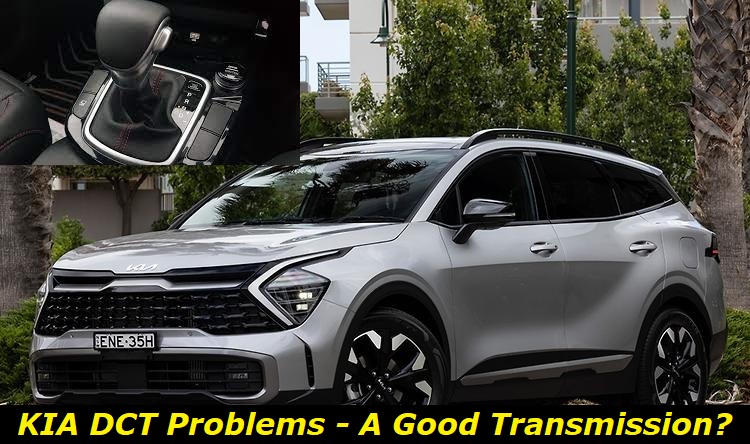The DCT transmission (Dual Clutch Transmission) is simply an automatic transmission that is a hybrid of manual transmission and automatic shifting technology. We don't tend to do a lot of technical research when we are buying a vehicle and this may do some bad things, we should say. When you see that your car is equipped with DCT, you should learn more about this technology before you get problems.
Kia DCT transmissions highlights
- Average lifespan:100,000-120,000 miles
- Reliability Score:Low
- Prone to minor issues:Yes
- Price for repair after failure:$1,300-$2,500
- Price for replacement:$3,500-$5,000
- Availability of parts:Good
- Common problems:clutch kit failure, electronic glitches, control module problems, fatal failure.

What types of DCT does KIA use now?
Currently, at the end of 2022, KIA and Hyundai start using wet-clutch DCT transmissions. And this is a big relief for potential buyers. Before that, the 7-speed DCT unit was a dry-clutch unit with two clutches that cost a fortune and were prone to damage even when the mileage was still very low.
But still, a lot of cars are sold now with the old transmission types and you should ask a manager in the dealership which kind of transmission is used in the car you are going to buy. New 8-speed wet-clutch transmissions are going to be undoubtedly better than the old 7-speed ones.
Here's what differs this DCT from other transmission types:
- this is basically the manual transmission with an automatic module controlled by the special computer called TCM - transmission control module;
- the shifting is achieved with the mechatronic that operates through two clutches;
- in wet-clutch transmission both clutches operate in transmission fluid while in dry transmissions they don't get oiled, just operate till they die without any fluid on them;
- the technology allows KIA to embrace all advantages of automatic transmissions and add some advantages of manual ones;
- the units that are prone to failure are TCM and clutches, but sometimes mechatronics also malfunction and cause problems;
- unfortunately, the construction of clutches makes them one of the most expensive parts of this assembly.
We can't say that the DCT offered by KIA is somewhat different from what other companies offer. These transmissions are pretty much the same in terms of construction, reliability, and common problems.
The best thing about these transmissions is that they offer unexpectedly good gas mileage and very smooth shifting (up until something goes wrong). This means that these transmissions are good to buy new because you will economize fuel and save your money. Also, driving your KIA equipped with the DCT transmission is a pleasure because the vehicle goes smoothly and doesn't jerk even a little when shifting gears.
Wet-clutch and dry-clutch options - what to choose?
For KIA cars, it's just the same as for any other manufacturer: if you have the choice, the wet-clutch transmission is something you should go for.
Dry-clutch transmissions can get problems at any time. They aren't reliable and are far from being durable. You just can't be sure that your vehicle will manage to finish your trip successfully at the destination point even if this vehicle has only 20K miles on it.
Wet-clutch transmissions are much more reliable but need more maintenance costs. And still, we would only buy wet-clutch transmissions if we ever agree to buy a vehicle equipped with DCT.
Just one example. You may remember that between 2010 and 2015 Volkswagen used a lot of its DCT transmissions called DSG. And the 7-speed DSG used for smaller engines was awful - it required to repair and maintenance so often that your fuel economy couldn't compensate for expenses.
But the 6-DSG transmission for more powerful engines was marvelous. It could go over 250,000 miles with basically no problems. You should know that the 6-DSG was a wet-clutch DCT while the 7-DSG was a dry-clutch DCT.
How long will the KIA DCT unit go?
It's extremely hard to predict anything here because we've found a couple of reports where people say their 7-DCTs required clutch replacement after just 10K miles and less than 1 year of driving. While some other owners of cars equipped with these transmissions say that they already passed the 50K-mile mark and the DCTs are still OK and working like new.
So, here some kind of lottery comes into action and you have some chance of losing it and repairing your transmission very early. Thank goodness, the majority of these repairs will be paid for by dealers.
We predict that the average lifespan of dry-clutch DCTs offered by KIA and Hyundai will be around 100,000 miles. While wet-clutch DCTs should go for about 150,000 miles, on average.
Again, these are just some average figures. Some owners will be luckier than others, though.
What are some of the common problems with KIA's DCT transmissions?
It's not enough time now to make any deductions about the most common problems. But still, some owners have already reported about issues and we are ready to predict more. The construction is just the same as in other DCTs, so some common issues are to happen.
We believe, these will be the most annoying problems for DCTs made by Hyundai (mainly, for dry-clutch ones):
- Clutch problems. When your vehicle experiences clutch issues, there is no other way for solving them but replacing the clutch assembly. This may cost you over $1,200 for clutch parts and another $500 for labor depending on where you are going to have it repaired.
- TCM issues. The transmission control module is not likely to live a long and happy life in these transmissions. It operates in bad conditions and experiences bad loads which lead to inevitable problems over time.
- Clutch forks. Sometimes, when the DCT starts acting up, it's not about the clutch, but just about forks. They are not as expensive as the whole assembly, but to replace them, you will still need to pay about $500 for labor - the transmission will need to be taken apart.
- Mechatronic problems. One of the parts of the DCT transmission is the unit that physically shifts the gears when the TCM tells it to do that. These units are also prone to damage and problems. They may be stuck and your car is not going to go anywhere till you repair or replace it.
As a rule, most problems with modern TCM transmissions are solved by replacing the damaged module. No one will repair your TCM or mechatronic because this repair is going to be expensive and short-term. So, you better have the warranty or just get ready to kiss goodbye with a solid sum of money.
How can you prolong the life of your KIA DCT?
Someone will say it's impossible, but we know that KIA has even issued a set of rules and recommendations on how to handle your DCT transmission. So, we believe, they just want to get rid of massive expenses on warranty replacement and repair. It would be nice to read and follow those guidelines.
Also, you could do the following:
- never tow anything heavier than the official towing capacity of your vehicle;
- this transmission is not made for sport, so drive carefully and forget about abusive driving;
- never let the selector rest on D mode when the car is standing still for more than 1 minute;
- always use your handbrake when parking on a hill, don't rely on transmission's P mode only;
- don't use manual shifting much because you may easily damage your transmission this way;
- keep up with all guidelines for maintaining the transmission.
Even if you follow all of these rules and recommendations, you may find your transmission broken one day. DCTs are not very reliable and they can surprise you with how early they can start being problematic. So, we wouldn't buy a KIA vehicle equipped with the DCT gearbox, especially if it's a used car with some mileage on it.
Final words
We believe DCTs are not the best option and you should find a way to buy a traditional torque converter if it's possible. But more brands choose technologies that help save fuel and prepare their future cars to challenge those emission standards. That's why DCTs, CVTs, and other unreliable technologies are going to develop while old reliable transmissions will go to history.
If you have already bought a car with the DCT transmission, drive it carefully and maintain it according to the guidelines KIA gives. Also, never overlook any symptoms that may mean a bad transmission, clutch, TCM, or whatever.
About the authors
The CarAraC research team is composed of seasoned auto mechanics and automotive industry professionals, including individuals with advanced degrees and certifications in their field. Our team members boast prestigious credentials, reflecting their extensive knowledge and skills. These qualifications include: IMI: Institute of the Motor Industry, ASE-Certified Master Automobile Technicians; Coventry University, Graduate of MA in Automotive Journalism; Politecnico di Torino, Italy, MS Automotive Engineering; Ss. Cyril and Methodius University in Skopje, Mechanical University in Skopje; TOC Automotive College; DHA Suffa University, Department of Mechanical Engineering






Add comment